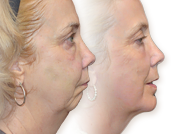What is Rhinoplasty?
Rhinoplasty, or nose reshaping surgery, improves the shape, size, and symmetry of a person’s nose, bringing it into better proportion with the rest of the face. When performed by a skilled, qualified cosmetic surgeon, rhinoplasty can be a rewarding and life-enhancing procedure—patients often notice that their overall appearance has improved, as the nose they see now looks natural, like the nose they have always thought they should have.
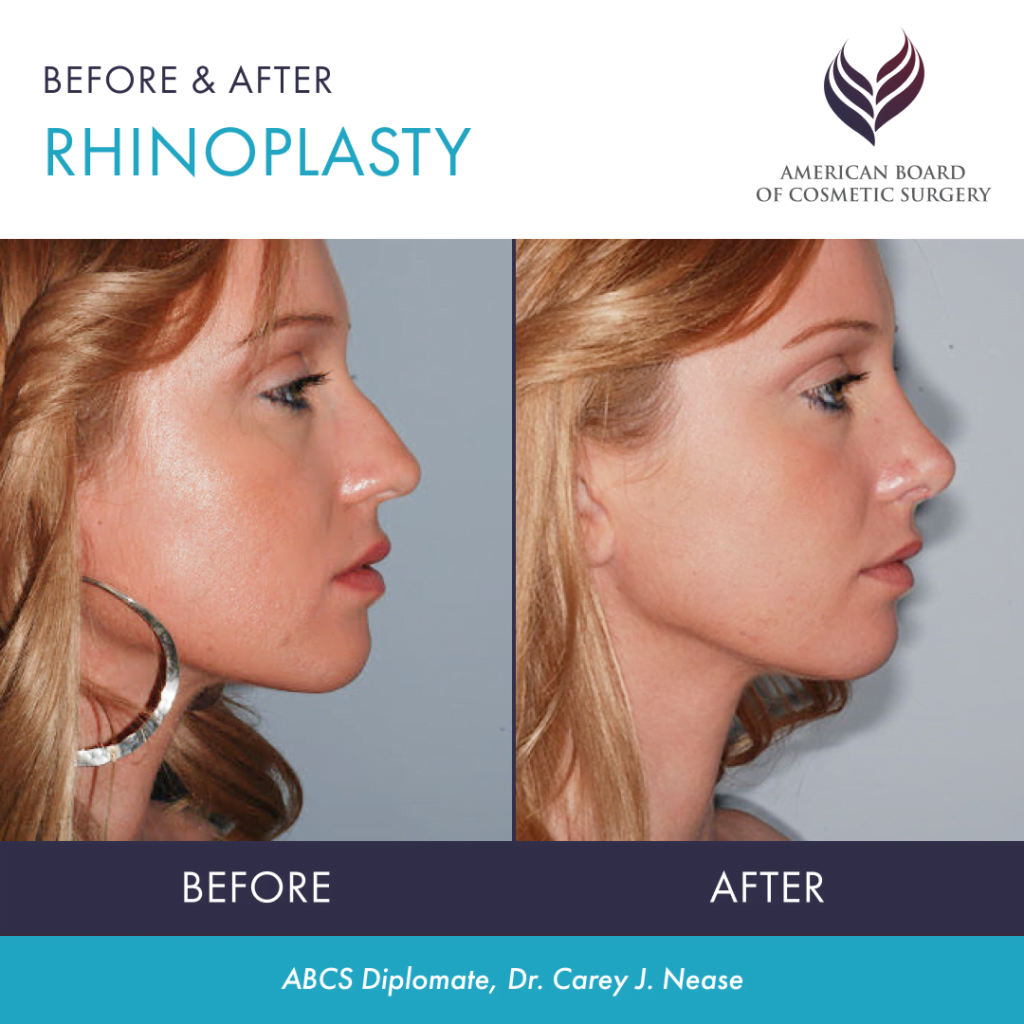
What changes can I make to my nose?
The goals of nose reshaping are as individual as the patients who choose to have rhinoplasty. By reshaping the nasal structures, including bone, cartilage, and skin, a cosmetic surgeon can help achieve one or more of the following:
- Straighten a crooked nose
- Smooth a prominent bump in the bridge of the nose
- Reduce the length of an over-protruding nasal tip
- Refine the size of a bulbous nasal tip
- Narrow a nose that is too wide for the face
- Reduce the size of a nose that is too large
- Restore symmetry to the nose following injury
- Correct breathing problems by opening up blocked nasal passages
In this video, ABCS diplomate Dr. J. Kevin Duplechain discusses the patient process during a rhinoplasty (or nose job) and the importance of the consultation for bringing surgeon and patient onto the same page about what the patient desires for their final results.
Am I a Good Candidate for Rhinoplasty?
Men and women of all ages benefit from rhinoplasty. Nose reshaping is one of the more popular cosmetic surgery procedures for teenage patients too, although cosmetic surgeons take special care when evaluating whether or not a younger patient is ready for rhinoplasty. Physically, the nose must be fully developed—typically by around age 14 for girls and 16 for boys. Younger patients also need to demonstrate emotional maturity and understanding about the cosmetic surgery process.
For patients of any age, it is important to have realistic expectations. Rhinoplasty can help you improve upon your existing nose, but it cannot deliver “perfection” nor can it give you the nose of someone else. A skilled, qualified cosmetic surgeon will explain to you what is possible and help you achieve a nose that looks natural with your unique features.
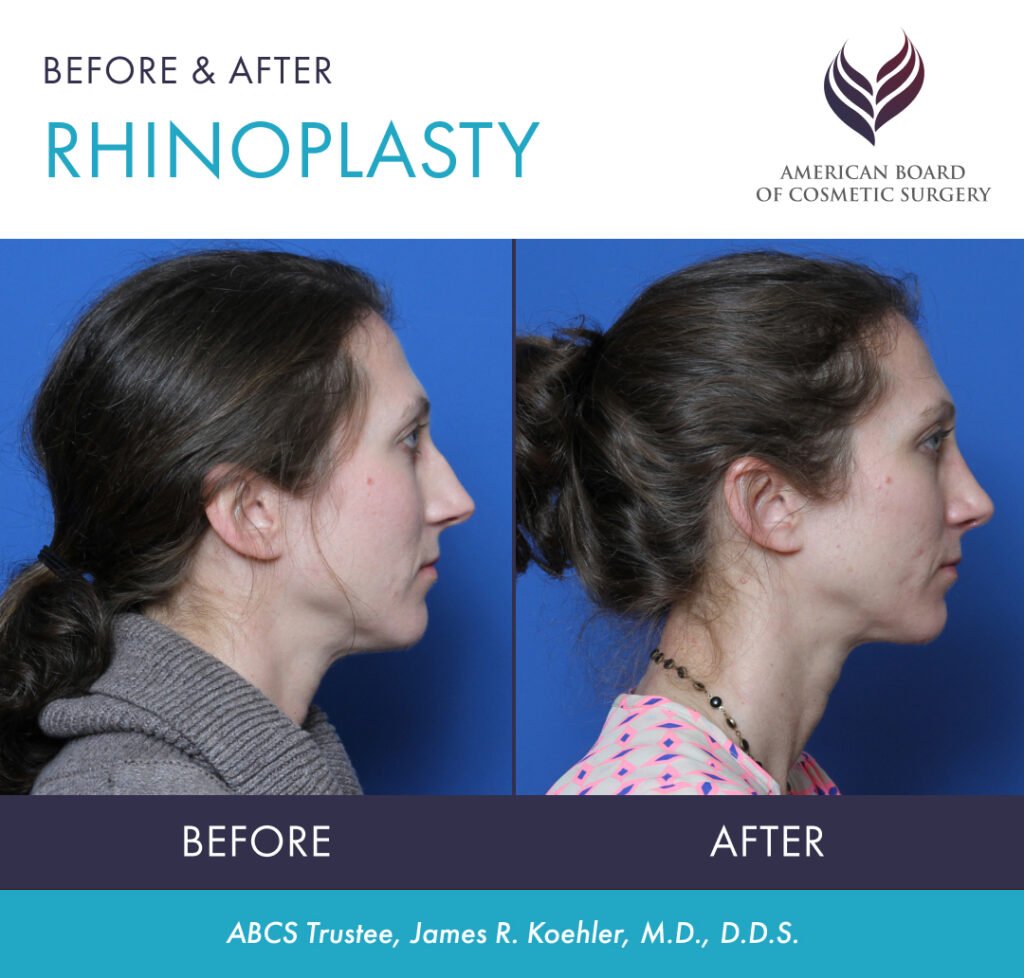
Choosing a Rhinoplasty Surgeon
Rhinoplasty is a highly complex procedure that demands a specially trained cosmetic surgeon. Choose a surgeon who has extensive experience in facial cosmetic surgery and performs rhinoplasty as a significant portion of his or her practice. Learn more about ABCS surgeons.
When consulting with potential surgeons, ask how many rhinoplasty procedures he or she has performed, and be sure to look at before and after photos of prior patients. The results you see should look natural to each individual patient, and you should like the results you see—this indicates a surgeon whose aesthetic sensibility aligns well with yours. Get more tips on choosing a cosmetic surgeon.
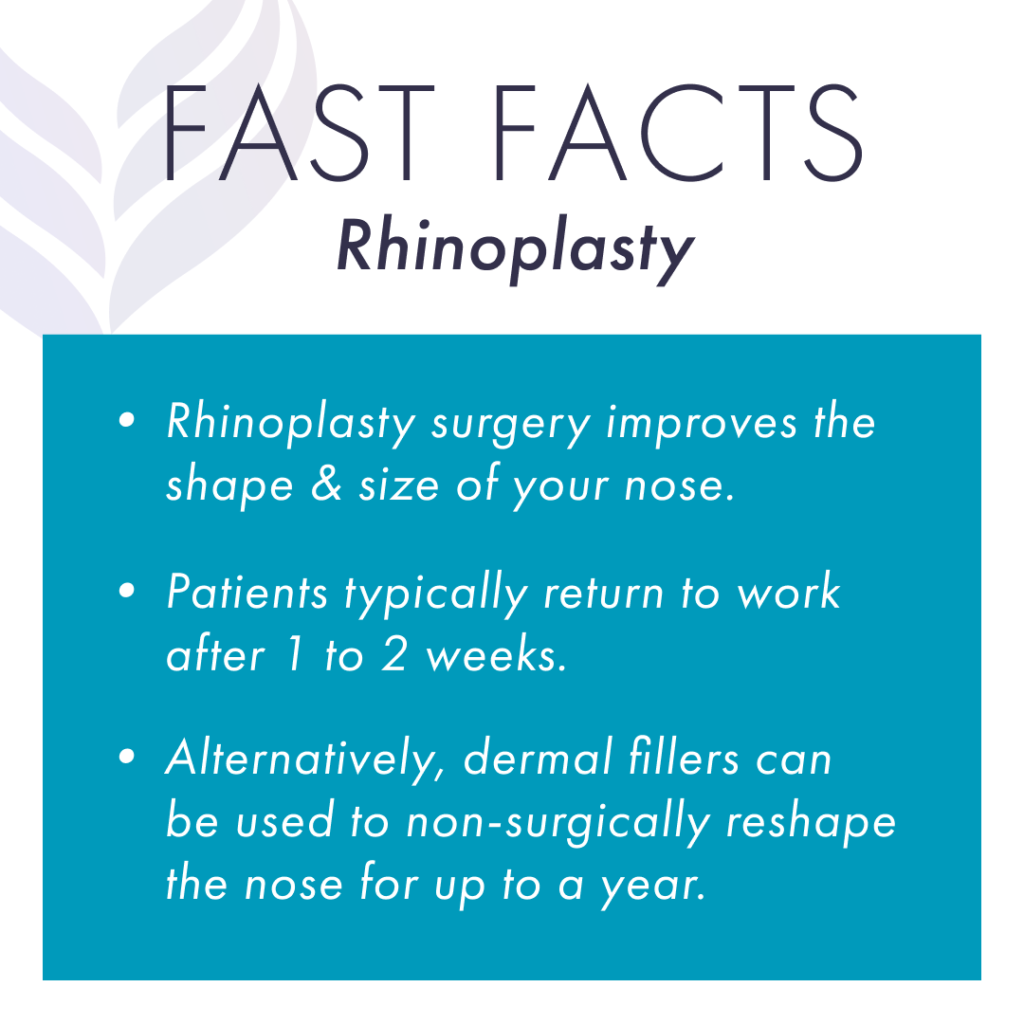
- Key Benefits
- Glossary
- Improves nose shape: Rhinoplasty can correct a wide range of aesthetic issues with the nose, such as a bump on the bridge, a bulbous tip, or a deviated septum.
- Enhances facial balance: By improving the shape of the nose, rhinoplasty can enhance the overall balance and symmetry of the face. This can be particularly beneficial for individuals who feel that their nose is disproportionate to the rest of their features.
- Improves breathing: In addition to cosmetic benefits, rhinoplasty can also improve functional issues with the nose, such as difficulty breathing due to a deviated septum or other structural issues.
- Cartilage: A tough, flexible connective tissue found in various parts of the body, including the ears, nose, and joints.
- Deviated Septum: A condition in which the nasal septum, the thin wall that separates the nostrils, is crooked or off-center, causing breathing difficulties.
- Nasal Tip: The lowermost part of the nose that defines its shape and appearance.
- Dorsal Hump: A prominent bump or elevation on the bridge of the nose.
- Nasal Valve: The narrowest part of the nasal airway, responsible for regulating airflow and maintaining nasal function.
- Nasal Reconstruction: Surgical procedures performed to restore or improve the shape, structure, or function of the nose, often due to trauma, birth defects, or previous surgeries.
- General Anesthesia: A state of controlled unconsciousness induced by medications to eliminate pain during surgery.
- Columellar Strut: A graft or support structure placed in the columella, the vertical strip of tissue between the nostrils, to provide structural support during rhinoplasty.
- Open Rhinoplasty: A surgical technique in which an incision is made across the columella, allowing for direct visualization and access to the nasal structures during the procedure.
- Closed Rhinoplasty: A surgical technique in which all incisions are made inside the nostrils, resulting in no external visible scars.
- Septoplasty: A surgical procedure performed to correct a deviated septum by straightening and repositioning the nasal septum, improving breathing function.
- Filler Injections: The injection of soft tissue fillers, such as hyaluronic acid or collagen, into specific areas of the face to restore volume, reduce wrinkles, or enhance facial contours.
- Ethnic Rhinoplasty: Rhinoplasty procedures specifically tailored with techniques to address the aesthetic concerns and unique anatomical characteristics of individuals from certain ethnic backgrounds.
Types of Rhinoplasty
Nose surgery is highly individualized, and the exact techniques a cosmetic surgeon will use during a procedure will look a little different each time, depending on a patient’s anatomy and desired changes. In general, however, a cosmetic surgeon’s techniques will fall under one of the following procedural approaches.
Open Rhinoplasty
For an “open” rhinoplasty, a small incision is made under the nasal tip, between the nostrils. This approach allows the cosmetic surgeon more complete access to the nasal structures, where he or she can then sculpt the nose into the desired shape. Because of this increased access, cosmetic surgeons will typically use the open rhinoplasty approach for patients requiring more extensive reshaping. The resulting scars are well-hidden in the natural contours of the nose so they are as inconspicuous as possible.
Closed Rhinoplasty
For a “closed” rhinoplasty, incisions are made inside the nostril. This approach is most commonly used for patients who need more minor adjustments to the nasal structures to achieve their desired improvements. The advantage of closed rhinoplasty is that there is no visible scarring after surgery; however, this approach may not be suitable for more extensive rhinoplasty procedures.
Tiplasty
A “tiplasty” refers to the area of reshaping, rather than the incision techniques. As you might have guessed, tiplasty involves reshaping the nasal tip only, without affecting the other nasal structures. Cosmetic surgeons may use the open or closed approach for tiplasty.
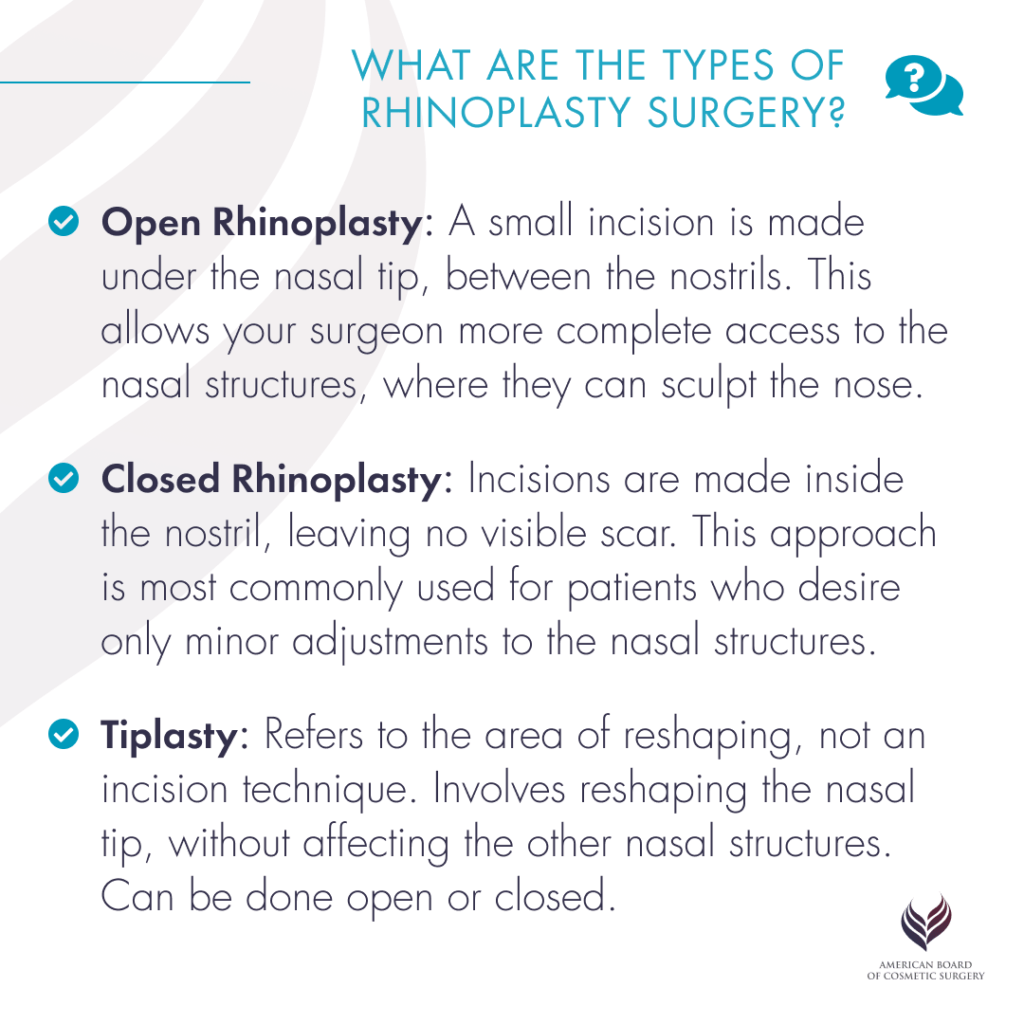
Is it possible to get a “non-surgical nose job”?
In certain cases, the nose can be reshaped non-surgically with dermal fillers, providing improvements that last up to a year. By strategically injecting a filler at certain points in the nose, a skilled cosmetic surgeon can help smooth out bumps, reshape the nasal tip, and improve nasal symmetry. Although the results are temporary, this non-surgical approach can be a cost-effective way for patients to “test-drive” a nose reshaping procedure before committing to the permanent changes possible with surgical rhinoplasty.
Life After Rhinoplasty
Rhinoplasty is typically performed as an outpatient procedure using general anesthesia, although local anesthesia with intravenous sedation may be appropriate in certain cases. After your procedure, your nose may be placed in a splint. This helps to support your newly reshaped nose and protect it from accidental contact. You may also go home with packing inside your nostrils—this can be uncomfortable, but temporary. Packing is typically removed within the first week after rhinoplasty. Your cosmetic surgeon will prescribe pain medication to help minimize discomfort during your initial recovery.
Take it easy after rhinoplasty
For the first 1 to 2 weeks, many patients experience bruising and swelling. At first, you may not be able to see the improvements made during surgery. But don’t worry—the majority of bruising and swelling should subside after the first 10 to 14 days. Most patients feel ready to return to work or school after 1 or 2 weeks, depending on the level of activity required. Typically after 3 weeks, most normal non-contact activities can be resumed. However, limit activity according to your surgeon’s instructions and do not engage in any strenuous activities until you are cleared to do so.
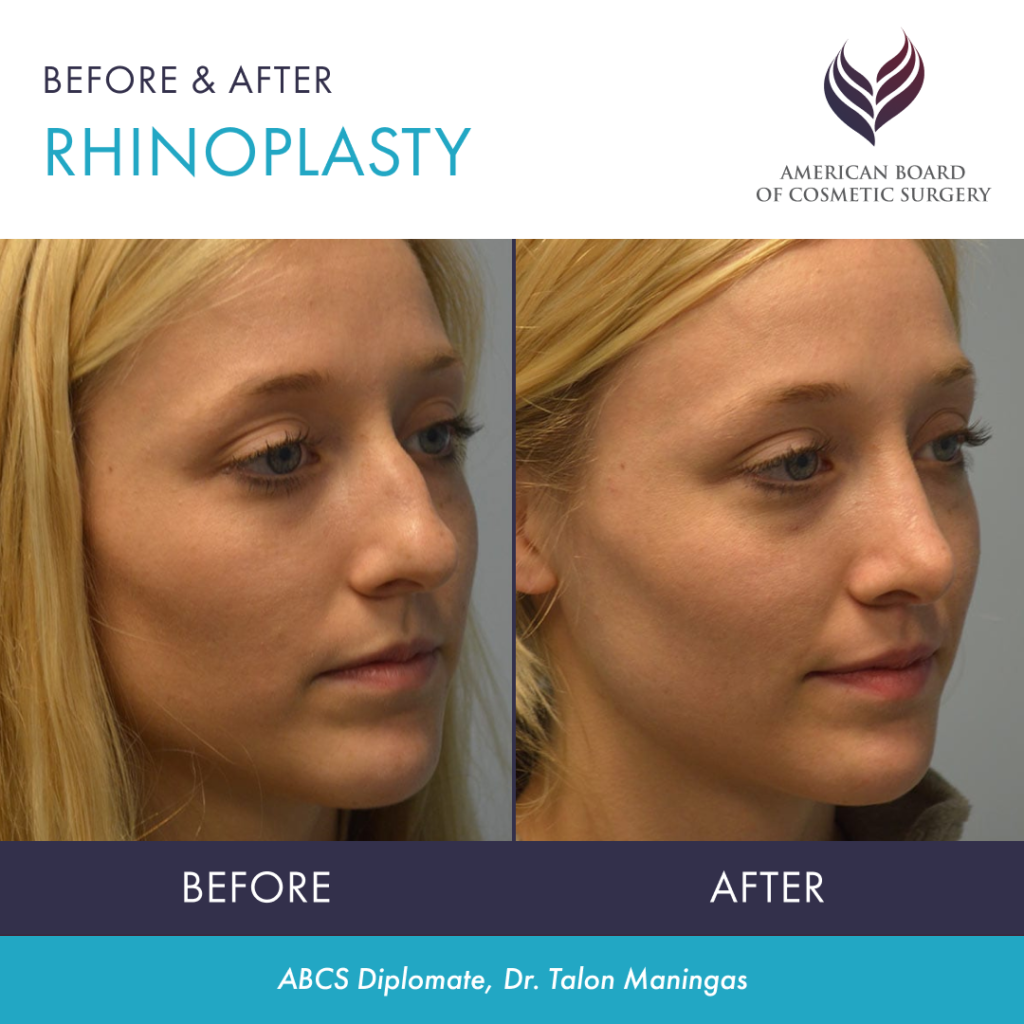
Your new nose will continue to improve
While you will be able to see the improvements your cosmetic surgeon made during rhinoplasty after the initial bruising and swelling dissipates, it is normal to have some slight residual swelling present for up to a year. This is usually not noticeable to others, though.
The results of rhinoplasty surgery are permanent. While this means your new nose will be with you for a lifetime, it also makes it that much more important to choose a qualified cosmetic surgeon whom you can trust to deliver the results you desire.
If you’re considering rhinoplasty, the best way to learn about your options is to meet with a board certified cosmetic surgeon for a consultation. You can find cosmetic surgeons in your area by using our ABCS Find-a-Surgeon tool.
References »
Klassen AF, Cano SJ, East CA, Baker SB, Badia L, Schwitzer JA, Pusic AL. Development and Psychometric Evaluation of the FACE-Q Scales for Patients Undergoing Rhinoplasty. Facial Plastic Surgery & Aesthetic Medicine. 2016. doi: 10.1001/jamafacial.2015.1445.
Mella J, Oyer S. Nonsurgical rhinoplasty: prevention and management of associated complications. Current Opinion in Otolaryngology and Head and Neck Surgery. 2022 Aug 1;30(4):241-248. doi: 10.1097/MOO.0000000000000818. PMID: 35906976.
Nassif PS, Lee KJ. Asian rhinoplasty. Facial Plastic Surgery Clinics of North America. 2010. doi: 10.1016/j.fsc.2009.11.018.
Saban Y, de Salvador S. Guidelines for Dorsum Preservation in Primary Rhinoplasty. Facial Plastic Surgery & Aesthetic Medicine. 2021. doi: 10.1055/s-0041-1723827.
Bouaoud J, Belloc JB. Use of injectables in rhinoplasty retouching: Towards an evolution of surgical strategy? Literature review. Journal of Stomatology, Oral and Maxillofacial Surgery. 2020. doi: 10.1016/j.jormas.2020.03.008. Epub 2020 Mar 20.
Halepas S, Lee KC, Castiglione C, Ferneini EM. Grafting in Modern Rhinoplasty. Oral and Maxillofacial Surgery Clinics of North America. 2021 Feb;33(1):61-69. doi: 10.1016/j.coms.2020.09.003. Epub 2020 Nov 3. PMID: 33153889.
